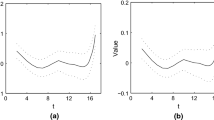Abstract
This paper is concerned with an algorithm for solving a large scale semi-definite logit model which cannot be solved by an outer approximation (cutting plane) algorithm proposed earlier by one of the authors. Outer approximation algorithm can solve a problem with up to 10 financial attributes and 7,800 companies which is less than satisfactory from the viewpoint of failure discriminant analysis. The new algorithm can generate an approximately optimal solution for problems with over 14 attributes and 8,000 companies, by which the quality of failure discriminant analysis would be substantially improved.
Similar content being viewed by others
References
Aldrich JH, Nelson FD (1984) Linear probability, logit and probit models. SAGE Publications, Beverly Hills
Bertsekas DP (1999) Nonlinear programming, 2nd edn. Athena Scientific, Nashua
Galindo J, Tamayo P (2000) Credit risk assessment using statistical and machine learning: basic methodology and risk modeling applications. Comput Econ 15: 107–143
Kelley JE (1960) The cutting-plane method for solving convex programs. J Soc Ind Appl Math 8: 703–712
Konno H, Kobayashi H (2002) Failure discrimination and rating of enterprises by semi-definite programming. Asia-Pacific Financ Markets 7: 261–273
Konno H, Thach PT, Tuy H (1997) Optimization on low rank nonconvex structures. Kluwer, Dordrecht
Konno H, Gotoh J, Uno T, Yuuki A (2002) A cutting plane algorithm for semi-definite programming problems with applications to failure discriminant analysis and cancer diagnosis. In: Paldalos P (eds) Financial engineering, E-Commerce and Supply Chain. Kluwer, Dordrecht, pp 379–396
Konno H, Kawadai N, Wu D (2004) Estimation of failure probability using semi-definite programming. J Comput Manag Sci 1: 59–73
Konno H, Kawadai N, Tuy H (2003) Cutting plane algorithms for nonlinear semi-definite programming problems with applications. J Global Optim 25: 141–155
Laitinen EK, Laitinen T (2000) Bunkruptcy prediction applications of the Taylor’s expansion in logistic regression. Int Rev Financ Anal 9: 327–349
Shirakawa H (2001) Credit risk management by scoring. Commun Oper Res Jpn 46: 628–634
Veinott AF Jr (1967) The supporting hyperplane method for unimodal programming. Oper Res 15: 147–152
Wolkowitz H, Saigal R, Vandenberghe L (2000) Handbook of semi-definite programming: theory, algorithm and application. Kluwer, Dordrecht
Author information
Authors and Affiliations
Corresponding author
Rights and permissions
About this article
Cite this article
Konno, H., Kameda, S. & Kawadai, N. Solving a large scale semi-definite logit model. Comput Manag Sci 7, 111–120 (2010). https://doi.org/10.1007/s10287-008-0078-z
Published:
Issue Date:
DOI: https://doi.org/10.1007/s10287-008-0078-z




